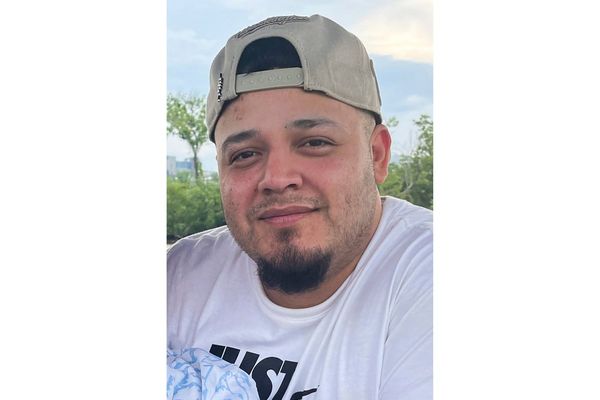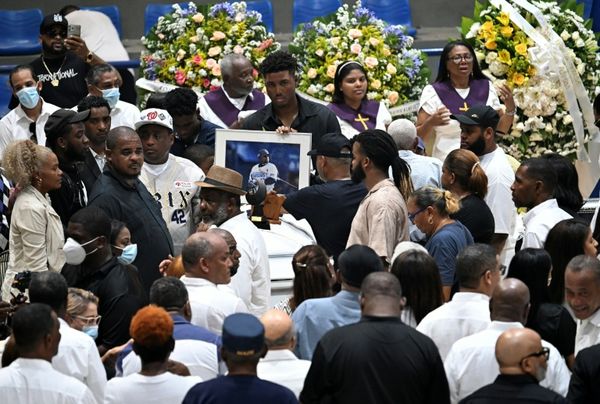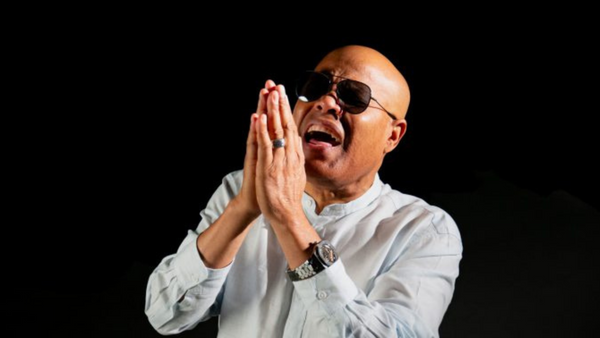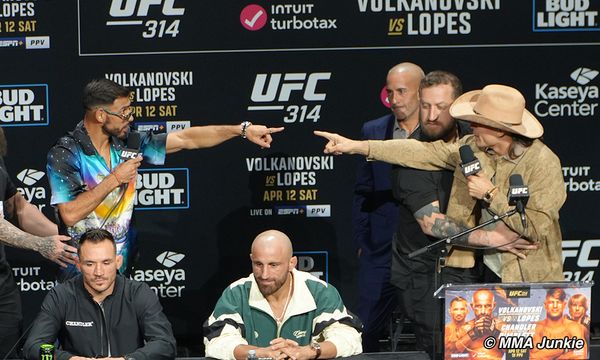
When their son was seven months old, strangers used to ask Kat West and Jaime Vallés if they fed him sedatives. “No, I don’t drug my baby!” West recalls with mock incredulity. “That was the weirdest question.” But it wasn’t: as Vallés reminds West, someone once asked if their son was animatronic.
West and Vallés were subject to this line of questioning because, for about six months in 2019, their baby boy Rafael played Bobby Carney in The Ferryman. Bobby, as you might have gathered, is also a baby – the youngest character in the Olivier-winning Troubles drama by Jez Butterworth. For the show’s production team, and ultimately its audience, a real baby was miles better than a doll. “The live baby added to the verisimilitude of the production,” said Tim Hoare, associate director at the time. During its Broadway run, four different babies became Bobby, with Rafael playing him four times a week.
“Played”, of course, could be overstating things. Rafael’s role involved sitting in the dark and being passed around by the adults. But he is just one of a number of babies who have trodden the boards. The Book of Dust: La Belle Sauvage – running at the Bridge theatre in London – also features real babies, cast as tiny infant Lyra, the protagonist of Philip Pullman’s famous His Dark Materials fantasy series. These babies raise a number of questions. How, exactly, do you audition an infant? Can you train one? And aren’t there a million stinky, shouty ways it can go less than all right on the night?
Just like adult actors, babies need agents. Bonnie Lia, founder of child talent agency Bonnie & Betty, says the last time they opened their books to babies, they received 1,300 applications, but could only represent 50. Who makes the cut? The aim is to get a wide range.

“It would be pointless,” says Lia, “to have 20 Caucasian baby boys all aged three months with brown hair and brown eyes.” Then, when a casting call comes in, the team can put forward babies of the right race and age. “Generally,” Lia explains, “we try to match the baby to the actors playing the parents.”
Then comes the audition – at which parents are placed under scrutiny, too. “They need to be flexible, committed, available at short notice,” Lia explains, “not too far from the location and laid-back with their baby possibly being handled by various cast and crew.” For modelling shoots and ads, sometimes babies are cast from photos or videos. But for theatre, directors need to see if a baby is prone to stage fright.
“Our audition,” Vallés explains, “consisted of handing the baby over to the stage manager, him bringing the baby to the middle of the stage in darkness, and putting Rafael down on a mattress for 20 seconds with weird, spooky music playing.” The reason was simple – that’s how act two of The Ferryman began. Rafael was second in line and the baby ahead cried bitterly when left alone. “I looked at my son and said, ‘All right, kid, you’re never gonna have a better shot than this, because the person in front of you just blew it.’”
West and Vallés responded to the casting call because both have experience in the arts – she’s a stage manager, while he works in video production. Rafael aced his audition. He stayed put on the mattress, didn’t cry at the bright lights, and wasn’t fussed when actors carried him around. By the time the production finished its run, West swears her son understood the concept of a cue light – the bulb that flashed when it was his time to go on. She says he never cried on stage once during his 48 performances.

James Cousins, co-director on The Book of Dust, also auditioned babies by running them through scenes in the show and checking that both baby and parents were relaxed. Adiya Ijaha, one of the show’s four babies, received glowing reviews: she was cast because she was “amazingly chill” but also “really engaged with what’s going on”. The cast joke that she has learned the script. “We like to think she knows exactly what she’s doing,” says Cousins, “and has been on stage in a previous life.”
Adiya had no real rehearsal time. The production didn’t involve the babies until the day before its first preview – before then, actors rehearsed with weighted dolls. When the babies finally arrived, they were taken through their five scenes over the course of two hours. Ultimately, the actors required more training than the infants – one of them had never held a baby before.
For Cousins, casting a real baby was a no-brainer: “This show, ultimately, is about a baby.” However, a doll is swapped in for fight scenes and when the cast are rocked on a boat. While the baby is in five scenes, it has – unsurprisingly – no cues once on stage, although Adiya has on occasion let out a coincidentally well-timed giggle.
Rafael was also in no way trained for his part: he was simply acclimatised to the stage and the actors. “They weren’t asking the baby to do anything,” Vallés explains. “It was the opposite: they wanted the baby to do nothing.” Sometimes, however, flukes meant that Rafael seemed trained. During the final scene on opening night, one actor asked another what the baby’s name was. “As soon as the actor said that, our son looked at the woman who was carrying him like, ‘What’s my name?’ And the audience died laughing because it looked like it was on cue.”
In film and TV productions, babies do have to emote on command. Because it’s unethical to scare a baby into crying, sometimes the crew simply wait until a baby is hungry or needs its nappy changed. Then they film it having a wail. In The Book of Dust, Lyra never has to cry or laugh on demand, but sometimes a baby actor has timed the weeping well. In one scene, Lyra is picked up by the father who abandoned her. He holds her at arm’s length. “If she cries at that point,” says Cousins, “we let it happen, as long as she’s not bawling the house down.” However, if the baby cries when it shouldn’t, “the actors know the things they can cut out in order to get the baby off stage.” And if a Book of Dust baby is crying right before she’s due on stage, they just swap in the doll.

So what about those tricky matters of child safeguarding? In The Ferryman, when Rafael was left alone on a mattress in darkness, two ushers stood on either side of the front row to ensure that no one in the audience leaned forward to snatch the baby. “Their only job,” says West, “was to stare at that baby until the baby got picked up by the actor, which was comforting.”
The show started at 8pm every night, meaning West and Vallés wouldn’t get Rafael back home until after 11pm. “He would often pass out on the way,” says Vallés. “Then it would be harder to put him to sleep later – that part was rough.” Book of Dust babies, meanwhile, have a 10pm curfew.
Lia explains that all children, no matter how young, require a performance licence issued by their local authority. In the UK, babies can get a licence at any age, even if they were born yesterday, although in California and many other US states, babies can only start acting when they’re 15 days old, and need a note from a doctor.
In the UK, the licence stipulates how many hours the child can be on set and how many breaks it must be given. Babies are also paid: West and Vallés were legally required to put a percentage of Rafael’s earnings in a trust fund. Some of the remaining money was used to offset the cost of one of the parents having to be in the theatre four times a week. “He had to pay taxes when he was barely one year old,” West laughs.
The family shared a dressing room with a standby baby and its parents. There was a one-hour break between its first entrance and its second, in which the parents would try to get their infant to nap. The standby baby had to be ready in costume in case Rafael had a bowel movement or started to wail. In fact, on his first ever performance, Rafael filled his nappy seconds before he was due on stage. Like a pro, he went on – although actors and front-row audience members might have preferred it if he hadn’t.
Cousins jokes that baby Adiya has a better backstage setup than most of the cast. They share dressing rooms, while the baby actor has one of its own. “They can have whatever they want there,” Cousins says. Adiya particularly favoured a baby bouncer hung on the door.
What, ultimately, is all this hard work for? Why not get an animatronic baby? “As soon as the baby is there,” Cousins says, “the energy on stage changes. The audience just lights up.” Baby Lyra is first brought on stage in a wheelbarrow: when she was revealed on opening night, the audience gasped. However, this excitement is not allowed to last too long. “Her moments on stage are kept quite short,” explains Cousins, “because the audience just stops listening to whatever’s going on.”







